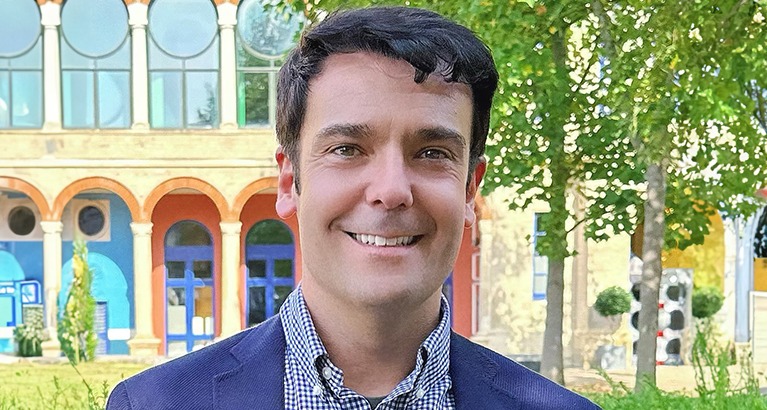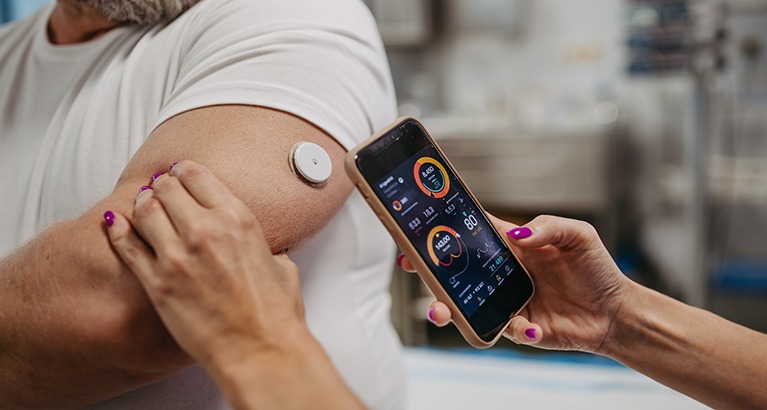Luis Garcia-Gancedo leads the Digital Health Strategy team in the Oncology Therapeutic Area at Evinova, a health tech business within pharmaceutical company AstraZeneca. After studying Physics and earning a PhD in Electronic Engineering, he first came to the University of Cambridge in 2009 as a post-doctoral Research Associate in the Department of Engineering and was a College Lecturer and Director of Studies at Newnham College.
We caught up with Luis, who talked about his career progression, approaches and barriers to developing cancer therapies, and the impact of his Cambridge experience:
Tell us about your post-doctoral research at the University of Cambridge, and subsequent career journey
My research focused on the development of novel miniaturised sensors and devices for disease diagnosis and management. Amongst other things, I developed a novel biosensor that could detect masses as small as 10-15 grams (the approximate mass of a virus), co-founded a diagnostics startup, and published several high-impact manuscripts in biomedical journals. After 5 years at the University, I had the opportunity to join GSK (pharmaceutical company GlaxoSmithKline), where I held a variety of roles in the digital health space. As my role evolved from a more technical focus to strategic in nature, in 2019 I decided to study for an Executive MBA at Cambridge Judge Business School. Last year, I joined AstraZeneca to set up and lead the Digital Health Strategy team in the Oncology Therapeutic Area, where I aim to make AZ’s oncology clinical trials more effective. Since joining, AZ launched Evinova, a healthtech business to accelerate innovation across the life sciences sector, the delivery of clinical trials and better health outcomes.
With a universal aim to beat cancer, what is needed to develop the best transformative cancer therapies to improve patients’ lives?
Clinical trials are the cornerstone of drug development due to their role in evaluating the efficacy and safety of new therapies. Despite their importance, clinical trials are still conducted in the most archaic way: recent research shows that the majority of data in oncology trials is still collected at clinical sites, very few cancer patients are willing to join a trial due to the burden, and there are many months lost due to processes, ultimately resulting in revenue loss and a delay in bringing new medicines to patients in need. Hence, there is a great need, and also an opportunity, to optimise the way we run oncology trials, particularly across 3 areas:
- patient recruitment and retention: it is often difficult for patients to find the right trials, and for sponsors to find eligible patients
- clinical trial complexity: cancer trials typically require frequent in-clinic visits and complex assessments which are burdensome for patients; although patients can benefit from in-person contact, reliance on clinical site visits are burdensome for many patients, particularly those living far away from clinical sites, who must navigate challenges due to the time and logistics for attendance.
- early detection and mitigation of treatment-related symptoms and toxicities: many cancer treatments result in patient symptoms that lower the patient’s quality of life during the clinical trial, and sometimes lead to dose reduction and treatment interruption or discontinuation
Innovative clinical trial designs enabled by digital technologies have the potential to address these (and other) inefficiencies, with the broad aim of conducting faster, cheaper, and more patient-centric trials which are less burdensome and more accessible for patients.
From your perspective, what do you feel are the greatest barriers to providing equitable cancer treatment for all? In an ideal world, how could these be overcome?
There are multiple factors leading to inequities in cancer prevention, treatment and followup, such as geographic, social, economic, or environmental differences. Another factor leading to inequity, which is perhaps less talked about, is patient diversity in clinical trials. Diversity is fundamental to understand aspects that may affect patients’ response to treatment, because people of different ages, races, and ethnicities may react differently to treatments. Without considering diversity, we can only have evidence to demonstrate treatments work in the specific patient populations that are represented in the trials, and so other populations (typically ethnic and racial minorities) are disadvantaged. Regulatory agencies have recently recognised that current racial and ethnic representation in clinical trials is inadequate and ultimately this is linked to health inequities. To enhance diversity, clinical trial sponsors need to consider trial designs that reduce barriers for participation, so that every patient has the opportunity to join a trial, for example by decentralising assessments to reduce the number of site visits, work with clinical sites to conduct studies in ways that enhance participation from currently under-represented populations, and promote recruitment strategies with pre-defined diversity metrics (and track progress against those metrics). This is only one, but an important step to eliminate a critical barrier in equitable cancer treatment.
How important is collaboration for cancer treatment development?
Collaboration is paramount given the increasing cost, complexity and multi-disciplinarity needed to develop new medicines, with each new therapy requiring an investment of over $1 billion over a period of 10 to 15 years from discovery to regulatory approval. No single department or organisation has all the skills, expertise or resources needed to beat cancer, and so in the past few years there has been increased collaboration with industry, academia and governments across many areas related to cancer research. These collaborative efforts offer a means to boost research activities to maximise the probability of success and enable medicines to be brought to patients in need more quickly. Interestingly, during my Executive MBA Individual Project, I noted this is a common trend for the industry sector, which is gradually moving from a ‘closed innovation’ approach into an ‘open innovation’ approach to benefit from the knowledge of partners – and so this model is not specific to oncology research, but certainly one that is critical for our ambition to beat cancer.
Did your Cambridge experience enhance your career in cancer-related fields?
Absolutely. It is unusual for someone working at the forefront of oncology clinical research to have a background in Physics and Engineering, and it is only possible through a career shift over time and continuous personal development. My first period at the University as a post-doc allowed me to focus my research on the field of devices for clinical/medical applications. This experience was crucial to allow me transitioning into the pharmaceutical industry. My second period at the University, as an Executive MBA student, provided me with business and leadership skills, as well as the network and confidence I needed to push my career further into clinical research. A particular highlight of my Executive MBA was the Individual Project, where I researched the topic of ‘Disruptive Innovation in the Pharmaceutical Industry’ under the supervision of Professor Shaz Ansari (Shahzad “Shaz” Ansari, Professor of Strategy and Innovation). During my Individual Project, I investigated why, despite their continuous investment in research and development (R&D), the pharmaceutical industry is not, at least apparently, disrupting itself as much as other industries such as the automotive or technology sectors. The insights that I gained are directly applicable to the field of cancer research, and ultimately enabled me to take up a leading role in oncology R&D at AstraZeneca.
Related content
Cambridge is changing the story of cancer
This year we’ve been highlighting cancer-related news and stories from Cambridge Judge Business School as part of a University of Cambridge-wide campaign, Cambridge is changing the story of cancer.





